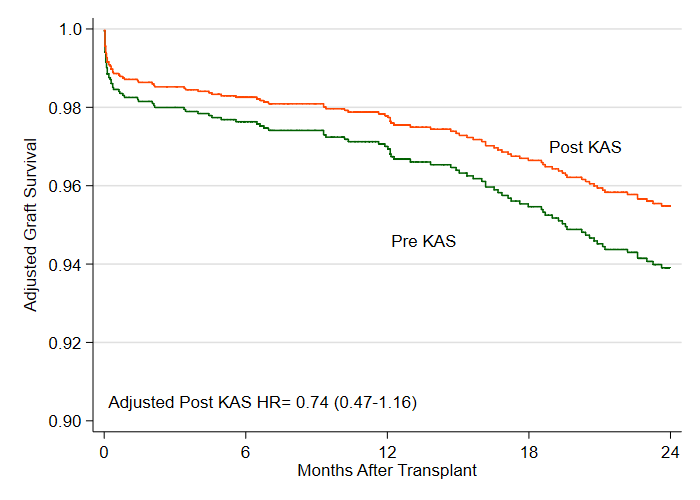Have Graft Outcomes Improved for Pediatric Transplant Recipients Since the Implementation the Kidney Allocation System
1Division of Pediatric Nephrology & Hypertension, McGovern Medical School at UTHealth - Houston, Houston, TX, 2Division of Nephrology, Department of Internal Medicine, Houston Methodist Hospital, Houston, TX, 3Renal Diseases &Hypertension, McGovern Medical School at UTHealth - Houston, Houston, TX
Meeting: 2019 American Transplant Congress
Abstract number: 132
Keywords: Allocation, Graft survival, Pediatric
Session Information
Session Name: Concurrent Session: Kidney: Pediatrics I
Session Type: Concurrent Session
Date: Sunday, June 2, 2019
Session Time: 4:30pm-6:00pm
 Presentation Time: 4:42pm-4:54pm
Presentation Time: 4:42pm-4:54pm
Location: Room 304
*Purpose: The new kidney allocation system (KAS) that utilizes a Kidney Donor Profile Index (KDPI) in matching transplant recipients to donors was implemented in December of 2014 but outcomes past 1 year in pediatric transplants have not yet been assessed.
*Methods: We compared patient and graft survival outcomes 31 months immediately pre- and post-KAS implementation in primary kidney transplant recipients <18 years old by Kaplan-Meier curves and incidence rates. We additionally examined and adjusted for recipient and donor characteristics that may explain any graft outcome differences seen pre- and post-KAS using Cox regression analysis with time-varying covariates.
*Results: A similar number of primary, deceased donor transplants occurred in pediatric patients during the preKAS period (n=1,089) and postKAS period (n=1,079). Recipients were similar in the two periods with the exception of longer wait times and years on dialysis before transplant as well as lower BMI in the postKAS period. There were minor changes in the matching and donor characteristics among pediatric transplants in the pre and post KAS periods with younger donor age, larger age difference, and more zero HLA mismatches in preKAS period. The crude, unadjusted analysis showed increased graft survival in the post KAS-period (94.5% at 2 years) in pediatric kidney transplant recipients compared to pre-KAS (92.5% at 2 years) (HR = 0.64, p = 0.034). However, after adjusting for recipient characteristics, the improved graft survival rate seen post-KAS was attenuated (HR = 0.72, p = 0.161). The most important indicators of reduced graft survival were female sex, black race, and pre-transplant dialysis (recipients in post-KAS period were slightly more likely to be female and initiated dialysis pre-transplant). Moreover, while pre-transplant dialysis is associated with longer wait time, longer wait time was not associated with worse graft survival.
*Conclusions: Despite recipients having longer wait and dialysis times as well as fewer zero HLA mismatches postKAS, this preliminary analysis indicates that KAS has not worsened graft survival in pediatric patients.
To cite this abstract in AMA style:
Bell CS, Hebert S, Golovine ADe, Swinford R. Have Graft Outcomes Improved for Pediatric Transplant Recipients Since the Implementation the Kidney Allocation System [abstract]. Am J Transplant. 2019; 19 (suppl 3). https://atcmeetingabstracts.com/abstract/have-graft-outcomes-improved-for-pediatric-transplant-recipients-since-the-implementation-the-kidney-allocation-system/. Accessed December 20, 2025.« Back to 2019 American Transplant Congress


